
Station Name: STOKE[Source:
Nick Catford]
Stoke Station Gallery 1: c1880s - 1967 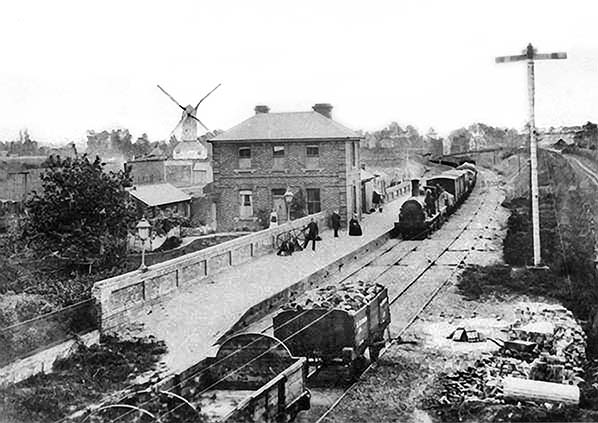 This well known image is generally dated to 1865, the year the station opened, but some time spent examining it closely reveals the date to be rather later and specifically between 1883 and 1892. The lengthy goods train has been halted for the obviously posed, as was necessary at the time, photograph with a member of the locomotive crew standing alongside the boiler. The locomotive is, following some careful analysis, a GER Class Y14 0-6-0 (later LNER/BR Class J15), a type introduced in 1883 hence the earliest possible date year. It is paired with a much earlier tender which appears to be a four-wheeled, outside framed example typical of the mid-19th century. Several of the Y14s were so-paired originally. Quite obvious under examination is the cab; a quite low and rudimentary structure with wooden roof covered in lead-painted canvas - a feature the class was to retain until LNER days when higher, steel-roofed cabs were fitted which gave the class its most familiar appearance. The signals with tall, shared post on the right were located for sighting purposes due to the curvature of the line from the Clare direction and the road bridge from which the photograph was taken. The two wagons in the foreground were typical of the period and the GER referred to them as 'Half Moon' wagons. They were general merchandise wagons and depending on contents would be covered by a tarpaulin secured by ropes. At least one wagon has sprung buffers but the detached and loaded wagon retains dumb buffers, a feature then rapidly falling out of favour and which would ultimately mostly be confined to internal user wagons on industrial systems. The writing on the loaded wagon is by no means clear but appears to say "Gt. Eastern Railway". On the platform, with a man posing beside them, is what looks like two wheels of the type used to operate crossing gates from within signal boxes but it is impossible to confirm. In the left background stands Stoke Post Mill, the only one of Stoke's three mills across the years to have been a Post type. This mill was demolished in 1892, hence the latest possible date for the photograph. One further feature of note is the track ballast covering the sleepers. This practice was commonplace in the 19th century but was outlawed sometime in the early years of the 20th century as it encouraged sleeper rot and concealed this and other track defects,
Photo from John Mann collection 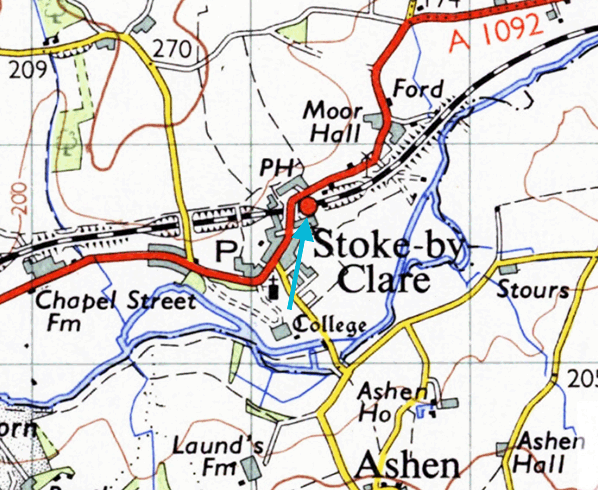 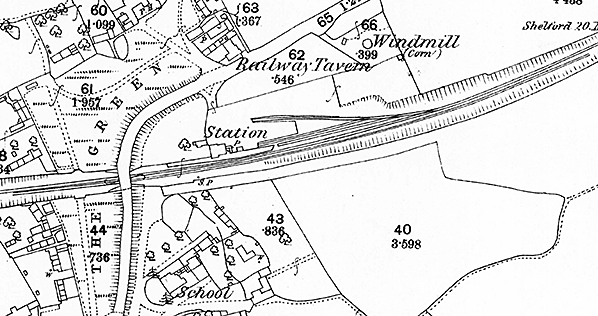
1887 1:2,500 OS map. The layout of the station is clearly shown with a wide goods dock flanked by two sidings. The goods loop on the down side is shown with no connection to the main line. At this date the signal box had not been built.
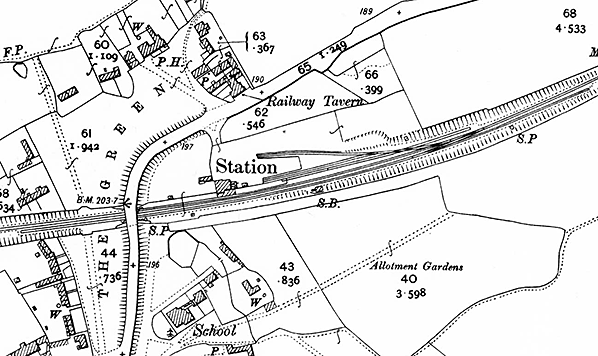 1904 1:2,500 OS map. The main difference with the earlier map is the addition of the signal box on the down side which was probably built in the 1890s. The goods loop is now conncted to the main line at the east end but still no connection is shown at the west end. A small building has appeared at the west end of the platform, this is probably a lamp room. Stoke post mill was demolished in 1892 and is omitted from this map.
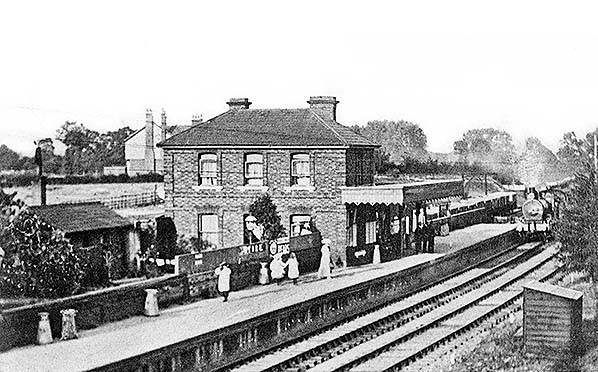
Stoke station on a summer day during the Edwardian period, showing the clothing, advertisements and milk churns so typical of a bygone age. A westbound passenger train is approaching, the locomotive being difficult to positively identify but appears to be a Class T26 2-4-0 complete with original and smaller style of smokebox door. Class T26 came to be better known as LNER/BR Class E4. The headcode disc mounted afore the chimney is of the coloured-centre type peculiar to the Great Eastern and which survived into BR days on London suburban services. Conspicuous by its absence in the background, Stoke's Post Mill had been demolished in 1892. The purpose of the hut in the right foreground is not known. Stoke's goods yard was rarely photographed but this views offers a glimpse of part of it with a rake of open wagons and a loading gauge gantry. The building in the background to the left of the station is the Railway Tavern.
Copyright photo from John Alsop collection old9.jpg)
'Footballer' Class B17 4-6-0 No.61666 Nottingham Forest arrives at Stoke with a train for Cambridge comprised of Gresley and Thompson suburban stock. The locomotive is quite grubby but shows signs of a fairly recent repaint and is wearing the BR emblem introduced in 1956. No.61666 was a Colchester locomotive from May 1954 until November 1959 and she was withdrawn from Stratford in March 1960. The station house shows off a brand new television aerial; television did not reach this area until October 1959 and although the aerial may have been pre-emptive it does, along with the locomotive details, permit us to date this photograph to sometime in 1959. This was of course into the age of the diesel multiple-unit but nevertheless locomotive haulage remained on the Stour Valley Line until the end of the Sudbury - Shelford section; most notably with the mixed passenger/parcels train to/from Cambridge which, following the end of steam, was hauled by a Brush Type 2 or sometimes in summer a BTH Type 1. On leaving Stoke, No.61666 will pass through the cutting which took the line through the middle of Stoke's village green and beneath a series of bridges of which only one remains today. The track nearest the camera was a goods loop but, as on this occasion, seems to have been used mainly as a siding for wagons. Stoke's rarely photographed goods yard was squeezed in between the passenger station and the main road through the village, today the A1092.
Photo copyright Colour-Rail BRE366 old5.jpg)
Stoke station looking west on a winter day c1960. The line on the left is a loop but it wasn't used for two passenger trains to pass. Goods trains could use it to allow passenger trains to pass although much of the time, it seems to have been used as a siding for grain wagons as seen in photos below. A short trap siding is seen at the west end of the loop under the bridge. There is a 'way out' alongside the gents' toilet at the east end of the building.
Photo from John Mann collection old3.jpg) Looking east from the road bridge (A1092) in 1961. A rake of 20-ton bulk grain wagons is seen on the loop. The building on the far left is probably a lamp room.
Photo from DK Jones collection old7.jpg)
Another view of Stoke station in 1961 looking east along the platform. Many photographs from this period show grain wagons in the goods loop.
Photo
from John Mann collection
old6.jpg)
Looking east from Clare station in 1961. The goods yard was behind the station at the east end. The loading gauge can just be made out beyond the platform.
Photo from John Mann collection old4.jpg)
Stoke station looking west in summer 1965. The goods yard closed on 19 April 1965 and the goods loop and presumably the sidings have already been lifted. Although the station would remain open to passengers for another two years, weed growth has taken over the rear of the platform and could perhaps be mistaken for a well tended station garden. The station has been unstaffed since
29 January 1963. Photo by BDJ Walsh old8.jpg) Not long before the line closed, a Derby Lightweight DMU arrives at Stoke with a service for Cambridge. By this time conductor-guard working was in operation and goods facilities had been withdrawn from this section of the Stour Valley Line in October 1965, the goods loop at Stoke and the sidings behind the station being lifted shortly afterwards. Signalling had also been rationalised, in the case of Stoke many years previously, and the token section was latterly Cavendish - Haverhill Junction. Of the two ladies on the platform, one is carrying a small suitcase. Perhaps she had been visiting a friend or relative who was seeing her off on the journey home. The Derby Lightweights and compatible Metro-Cammell units were themselves nearing the end of their lives, in no small part as a result of line closures, with the last being withdrawn from passenger service in 1969. Not long before the line closed, a Derby Lightweight DMU arrives at Stoke with a service for Cambridge. By this time conductor-guard working was in operation and goods facilities had been withdrawn from this section of the Stour Valley Line in October 1965, the goods loop at Stoke and the sidings behind the station being lifted shortly afterwards. Signalling had also been rationalised, in the case of Stoke many years previously, and the token section was latterly Cavendish - Haverhill Junction. Of the two ladies on the platform, one is carrying a small suitcase. Perhaps she had been visiting a friend or relative who was seeing her off on the journey home. The Derby Lightweights and compatible Metro-Cammell units were themselves nearing the end of their lives, in no small part as a result of line closures, with the last being withdrawn from passenger service in 1969.Photo by Mary Cowle Click here for Stoke Station Gallery 2:  Home
Page Home
Page
|
 The goods yard was accessed from the east end of the station and comprised three sidings. Two ran parallel to the main line running behind the east end of the platform. The third siding ran diagonally across the yard. The two outer sidings ran either side of a wide goods dock. There was no goods shed but there were three additional brick buildings, one adjacent to the gents' toilet and another to the west of the station house. One of these might have been used as a good lock up. A third building at the west end of the station at the back of the platform was probably a lamp room. The yard handled a full range of goods traffic with the exception of livestock.
The goods yard was accessed from the east end of the station and comprised three sidings. Two ran parallel to the main line running behind the east end of the platform. The third siding ran diagonally across the yard. The two outer sidings ran either side of a wide goods dock. There was no goods shed but there were three additional brick buildings, one adjacent to the gents' toilet and another to the west of the station house. One of these might have been used as a good lock up. A third building at the west end of the station at the back of the platform was probably a lamp room. The yard handled a full range of goods traffic with the exception of livestock.
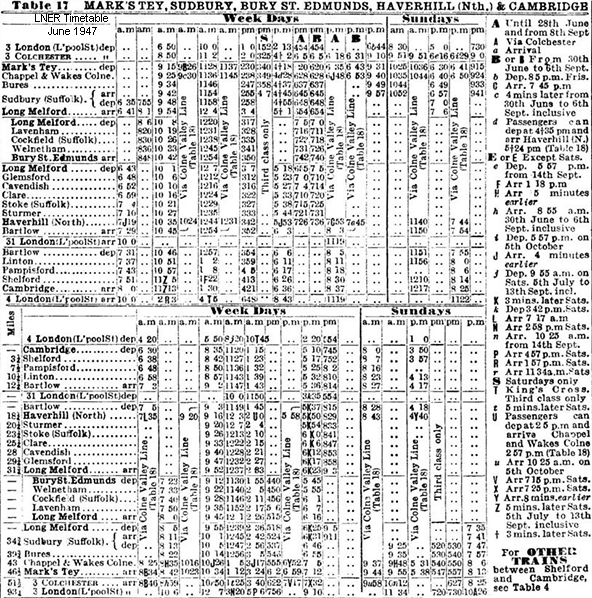
 The freight service was withdrawn from all the stations on the
Stour Valley line during the 1960's; the last station to lose
its freight service was Haverhill on 31.10.1966. Closure of the
Sudbury - Cambridge passenger service was delayed while local
councils considered providing annual subsidy; this was eventually
refused because of the high cost. The line from Sudbury to Shelford
closed entirely on 6.3.1967. In November 1969 the contract for
the removal of the permanent way was awarded to A. King and Sons
of Norwich and the track was lifted the following year.
The freight service was withdrawn from all the stations on the
Stour Valley line during the 1960's; the last station to lose
its freight service was Haverhill on 31.10.1966. Closure of the
Sudbury - Cambridge passenger service was delayed while local
councils considered providing annual subsidy; this was eventually
refused because of the high cost. The line from Sudbury to Shelford
closed entirely on 6.3.1967. In November 1969 the contract for
the removal of the permanent way was awarded to A. King and Sons
of Norwich and the track was lifted the following year.